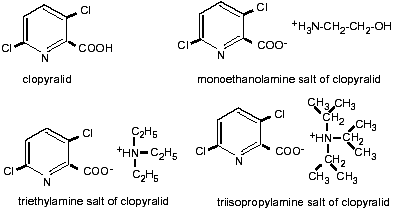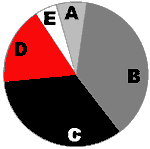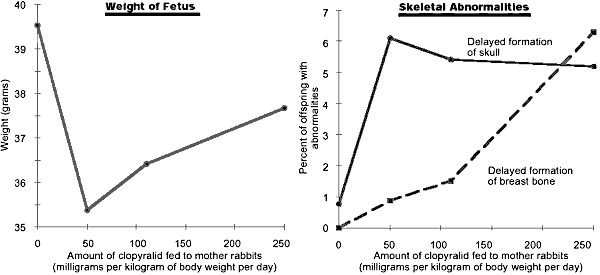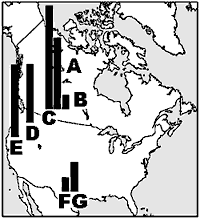Figure 1 Clopyralid

NORTHWEST COALITION FOR ALTERNATIVES TO PESTICIDES/NCAP P. O. BOX 1393, EUGENE, OREGON 97440 / (541)344-5044 http://www.pesticide.org/
Caroline Cox is JPR's editor.
Clopyralid (3,6-dichloropicolinic acid; see Figure 1) is an herbicide used to kill unwanted annual and perennial broadleaf plants in turf and lawn, range, pasture, rights-of-ways, and some agricultural crops.1 Its primary manufacturer is Dow AgroSciences and it has been registered for use in the U.S. since 1987.2 The acid form of clopyralid and three clopyralid salts (triethylamine, triisopropylamine, and monoethanolamine) are commonly used in commercial herbicide products.3-11 Common brand names under which clopyralid is sold include Transline, Stinger, and Reclaim.3-5 It is also sold in combination with other herbicides including triclopyr, MCPA, and 2,4-D; brand names of these mixes include Confront, Curtail, Scorpion, Hornet, and Accent Gold.6-11
|
Figure 1 Clopyralid | |
 |
The herbicide clopyralid is commonly sold under the brand names Transline, Stinger, and Confront. It is used to kill unwanted plants in lawn and turf, range, pasture, rights-of-way, sugarbeets, mint, and wheat. Clopyralid and the products containing it are irritating to eyes, some severely. The eye hazards of four clopyralid products include permanent impairment of vision or irreversible damage. In laboratory tests, clopyralid caused what a U.S. Environmental Protection Agency (EPA) reviewer called "substantial" reproductive problems. These include a reduction in the weight of fetuses carried by rabbits who ingested clopyralid, an increase in skeletal abnormalities in these fetuses at all doses tested, and an increase in the number of fetuses with hydrocephaly, accumulation of excess fluid around the brain. "Inert" ingredients in clopyralid products include cyclohexanone (produces tearing and burning of the eyes, vomiting, diarrhea, and dizziness), triethylamine (a severe eye irritant and cause of chemical pneumonia), and polyethoxylated tallow amines (cause eye burns, nausea, and are acutely toxic to fish). Clopyralid is "persistent" in soil, according to an EPA review, and field studies have measured persistence as long as 14 months. It has the chemical characteristics that make it a likely water contaminant; despite its relatively low level of use it has been found in 2 of the 20 river basins studied by the U.S. Geological Survey. Potatoes are extremely sensitive to clopyralid with damage occurring when plants are exposed to 0.07 percent of typical agricultural rates. When tubers from these damaged plants were grown in unsprayed fields, the new generation of plants also showed damage symptoms.
Use
The National Center for Food and Agricultural Policy estimates that agricultural uses of clopyralid in the U.S. total about 89,000 pounds per year. Most of this is used on sugarbeets, mint, and wheat.12 (See Figure 2.)
|
Figure 2 Agricultural Uses of Clopyralid in the U.S. A oats B sugarbeets C mint D wheat E barley F oats Total: 89,110 pounds per year Gianessi, L.P. and J.E. Anderson. 1995.
Pesticide use in U.S. crop protection.
Washington, D.C:
National Center for Food and Agricultural Policy, Feb |
 |
Mode of Action
Clopyralid is a synthetic plant growth hormone and has some structural similarities to naturally occurring hormones called auxins. It disrupts plant growth by binding to molecules that are normally used as receptors for the natural growth hormones.1 Because clopyralid is more persistent in plant tissue than auxins,13 the binding causes abnormal growth leading to plant death in a few days or weeks, depending on the species.1 Clopyralid is similar in structure and mode of action to the herbicide picloram.13
Acute Toxicity
In laboratory rats, symptoms of clopyralid poisoning include watery eyes, diarrhea, and lethargy. These symptoms appear between 2 and 48 hours after clopyralid ingestion.14 Acute exposure to clopyralid is also "severely irritating" to eyes, with symptoms (opaque cornea, inflamed iris, redness, and discharge) lasting up to 21 days after exposure.15 Commercial clopyralid products also damage eyes. Confront "may cause severe irritation"6 with effects that can be "slow to heal."6 These effects include "blurred, smoky, or halo vision."6 Curtail, Scorpion, and Hornet "may cause permanent impairment of vision, even blindness."7,9,10 Accent Gold "causes irreversible eye damage."11
In addition, clopyralid herbicides can irritate skin. Material safety data sheets for the products Hornet, Reclaim, Transline, Stinger, Curtail M, Curtail, and Scorpion all warn, "Prolonged exposure may cause skin irritation."3-5,7,8,10 Repeated exposure to Confront "may cause allergic skin reactions in some individuals," 6 and Accent Gold "may cause skin sensitization."11
Subchronic Toxicity
Subchronic (medium term exposure) studies of laboratory animals exposed to clopyralid have identified a variety of adverse effects. A three-month study with mice found an increase in the size of cells in the liver in females at two of the four doses tested. At the high dose, males showed similar effects and liver weights were increased in both sexes. A six-month study with dogs found increased liver weights in females, and urinary tract problems in males. Both effects were found at the highest dose tested.16
There are no publicly available studies of the subchronic effects of clopyralid-containing products.
Chronic Toxicity
Chronic (long-term exposure) studies of laboratory animals have identified effects on the stomach, liver, blood, and body weight. A two-year study with rats found hyperplasia of the stomach lining,
Figure 3 Reproductive Effects of Clopyralid
 |
Source: U.S. EPA. Office of Pesticides and Toxic Substances. 1991. 3,6-dichloro-2-pyridinecarboxylic acid (clopyralid): Review of a rabbit teratology study submitted by the registrant. Memo from T.F. McMahon, Health Effects Division, to E. Wilson, Registration Division. Washington, D.C., Mar. 20.
Clopyralid's reproductive hazards include reduced weight of offspring and an increased incidence of skeletal abnormalities.
an increase in the number of cells leading to an enlargement of the lining, at all but the lowest dose tested. A one-year study with dogs found an increase in liver weights and a decrease in the number of red blood cells, also at all but the lowest dose tested. A two-year study with mice found decreased weight of males at the highest dose tested.16 There are no publicly available studies of the chronic effects of clopyralid-containing products.
Effects on Reproduction
According to a U.S. Environmental Protection Agency (EPA) reviewer, laboratory tests have demonstrated that exposure to clopyralid results in "substantial"17 toxicity to fetuses and birth defects. (See Figure 3.) In a test with rabbits, clopyralid caused a decrease in the weight of the fetuses at both the low and the high dose tested. (At the middle dose the decrease in fetal weights occurred but was not large enough to be statistically significant.) In the same study, EPA also found that "developmental toxicity in the form of skeletal abnormalities was evident at all dose levels tested."17 These skeletal abnormalities included delayed bone formation in the skull, pubic bone, and breast bone. At the highest dose tested, a "substantial increase was found in the number of fetuses with hydrocephaly,"17 accumulation of excess fluid around the brain resulting in a small brain and an enlarged skull. There are no publicly available studies of the reproductive effects of clopyralid-containing products.
Carcinogenicity
EPA has not evaluated the ability of clopyralid to cause cancer. In addition, there are no publicly available studies of the cancer-causing ability of clopyralid-containing products.18,19
"Inert" Ingredients
Like most pesticide products, clopyralid products contain so-called inert ingredients. These are ingredients added to the pesticide product to make it more potent or easier to use. Only limited information about their identities is publicly available. The following inert ingredients have been identified in clopyralid-containing products:
Curtail M contains cyclohexanone.8 It produces eye irritation, tearing, and burning pain. It also causes skin irritation, nausea, vomiting, and diarrhea. It may cause liver and kidney damage, headache, dizziness, drowsiness, and nausea. Inhalation of cyclohexanone may be fatal as a result of spasms, inflammation, and fluid accumulation in the lungs.20
Curtail contains triisopropanolamine.7 It causes eye irritation, and may cause skin irritation. Inhalation of triisopropanolamine may irritate the respiratory tract, and may be fatal as a result of spasms, inflammation, and fluid accumulation in the lungs.21 Confront, Confront Weedstick, Confront F, and two Confront-fertilizer combinations contain triethylamine (N,Ndiethylanamine), ethylenediaminetetraacetic acid (EDTA), and polyethoxylated tallowamine (POEA).22
Triethylamine causes severe eye irritation, and may cause "blue haze" vision. It also causes skin irritation, and respiratory tract irritation which may lead to chemical pneumonia. It may irritate the digestive tract.23
EDTA causes eye irritation, skin irritation, and respiratory tract irritation. In laboratory tests it has caused reproductive problems, including stunting and death of fetuses and abnormal fetal development.24,25
POEA causes eye burns; skin redness, swelling, and blistering; nausea; and diarrhea. 26,27 Concentrations of POEA between 1 and 5 parts per million kill fish.26
Persistence in Soil
Clopyralid is "persistent"28 in soil, according to EPA, with a half-life (the time required for one-half of the amount of clopyralid to break down or move away from a test site) of "up to 11 months."28 Several studies have measured persistence under field conditions; clopyralid persisted in soil between 2 and 14 months depending on soil type, climate, and other factors.29-31 (See Figure 4.) Enough clopyralid persists in soil that lentils, safflower, and peas are damaged 220 days after treatment,31 and a fall application caused "severe potato growth reductions" in potatoes planted the next spring.32
Figure 4 Persistence of Clopyralid in Soil
 |
A 9.7 mos. B 2 mos. C 14 mos. D 7 mos. E 9.5 mos. F 2 mos. G 4 mos. |
Depending on soil type and climate, clopyralid
can persist up to 14 months in soil.
Sources: Pik, A.J. et
al. 1977. Fate of 3,6-dichloropicolinic acid in soils. J. Agric. Food Chem.
25:1054-1061.
Bovey, R.W. and C.W. Richardson. 1991. Dissipation of
clopyralid and picloram in soil and seep flow in the backlands of Texas. J.
Environ. Qual. 20:528-531.
Tanphiphat, K. and L.C. Burrill. 1987. Persistence
of clopyralid in soil. Proc. West. Soc. Weed Sci. 40:75.
Haderlie, L.C. and
D.K. Harrington. 1988. Potato growth and symptoms when grown in clopyralid soil
residue. West. Soc. Weed Sci. Res. Prog. Rep. Pp. 387-389.
Persistence in Compost and Mulches
Compost and mulches made from clopyralid-treated plants contain residues. A study from Michigan State University measured clopyralid in grass clippings composted for up to one year.33 Another study found that potatoes mulched with mint hay were damaged when the hay was made from plants treated with clopyralid the preceding spring.34 In a greenhouse experiment in which clopyralid-damaged bean plants were used as a soil amendment for subsequent plantings of beans, damage was visible for three generations.35
Contamination of Water
EPA described clopyralid as "very soluble"36 in water and "very mobile"36 in soil and concluded that it "has the potential to leach to ground water and/ or contaminate surface water."36 Relative to other herbicides, the amount of clopyralid used in the U.S. is small: for example, its use is about 0.1 percent of that of atrazine, the most widely used herbicide in the U.S.12 Atrazine is widely found as a water contaminant.37 Despite this low level of use, the U.S. Geological Survey has found clopyralid in two of the twenty river basins it has sampled for pesticides, the Central Columbia Plateau (Washington and Idaho) and the Trinity River Basin (Texas).38,39
Under "worst case" experimental conditions (application to a harvested, cultivated field followed by irrigation), clopyralid was found in soil water samples at all depths and dates tested, up to 30 days after treatment and down to a depth of 1.8 meters (almost 6 feet).40
Effects on Crop Plants
Clopyralid is "considered volatile,"41 according to EPA, meaning that it can evaporate from foliage and soil after application, move away from the application site, and "adversely affect nontarget broadleaf plants."41 EPA calculated that volatilization of only one percent of applied clopyralid would be enough to damage nontarget plants.41 For a sensitive crop plant, the amount causing damage is even smaller. Potato plants showed damages after exposure to 0.07 percent of typical agricultural rates, and 0.7 percent reduced potato yields.42 Potatoes are so sensitive to clopyralid that effects can be seen in plants the year following exposure. When tubers from clopyralid-damaged plants were grown in an unsprayed field, clopyralid injuries were visible in the new generation of potato plants.43
Hazards to Endangered Species
EPA has identified 11 species of endangered plants which could be jeopardized by the use of clopyralid.44 Five of these species are rare cactus species. The impact of clopyralid on endangered cactus has been studied in Arizona, by doing experiments with close relatives of the endangered species. The experiments showed that some of the cactus species were impacted for months following clopyralid treatment. Of the five species studied, one showed reduced vigor 16 months after treatment, one showed reduced survival and vigor for six months (this species is not easy to keep alive, and could not be evaluated for 16 months), and one showed reduced survival for 16 months.45
Effects on Plant Communities
Clopyralid is used in plant community restoration efforts in an attempt to kill alien (weed) species and promote the growth of native species. A study conducted in Glacier National Park found that clopyralid-based restoration has mixed results. After a highway in the park was widened, researchers attempted to reestablish native vegetation along the roadside. Study plots were seeded with native seed mixes, and treated three times with clopyralid. The abundance of nonnative broad-leaved species decreased and the abundance of native grasses increased slightly. However, the herbicide treatment also reduced the abundance of native broad-leaved plants and increased the abundance of nonnative grasses.46 An experiment in the United Kingdom showed similar results. After sowing seed from native species, treatment with clopyralid reduced the abundance of one of the seeded broad-leaved species about 75 percent and completely eliminated flowering by that species. Clopyralid treatment also eliminated flowering by two other species and reduced flowering of a third species by 90 percent.47
Effects on Beneficial Insects
Since clopyralid is an herbicide, it is not surprising that plants are the primary target of its toxicity. However, clopyralid is also toxic to some beneficial insects, those insects that are economically important because they reduce populations of agricultural pests. The International Organization for Biological Control found that clopyralid is toxic to three species of beneficial insects: between 30 and 80 percent of test populations of a ladybug and a pirate bug were killed by clopyralid, as were between 25 and 50 percent of populations of a lacewing.48
Resistance
Resistance to clopyralid was documented in a yellow starthistle population in Washington. The starthistle grew in a pasture that was treated frequently with picloram over a ten year period. Greenhouse studies showed that the starthistle had 3-fold resistance to picloram. (The amount of picloram required to kill the plants was three times the amount required to kill plants that had not developed resistance.) For clopyralid, the starthistle showed 14-fold resistance.49
References
1. DowElanco. 1997. Clopyralid: A North American technical profile. Indianapolis, IN, Oct.
2. U.S. EPA. Prevention, Pesticides and Toxic Substances. 1998. Status of pesticides in registration, reregistration, and special review. Washington, D.C., spring.
3. Dow AgroSciences. 1998. Material safety data sheet: Reclaim Herbicide. Indianapolis, IN, Jan. 1. http://www.dowagro.com/.
4. Dow AgroSciences. 1998. Material safety data sheet: Transline Herbicide. Indianapolis, IN, Jan. 1. www.dowagro.com.
5. Dow AgroSciences. 1998. Material safety data sheet: Stinger Herbicide. Indianapolis, IN, Jan. 1. www.dowagro.com.
6. Dow AgroSciences. 1998. Material safety data sheet: Confront* Herbicide. Indianapolis, IN, Jan. 1. www.dowagro.com.
7. Dow AgroSciences. 1998. Material safety data sheet: Curtail* Herbicide. Indianapolis, IN, Jan. 1. www.dowagro.com.
8. Dow AgroSciences. 1998. Material safety data sheet: Curtail M Herbicide. Indianapolis, IN, Jan. 1. www.dowagro.com.
9. Dow AgroSciences. 1998. Material safety data sheet: Scorpion III*. Indianapolis, IN, Jan. 1. www.dowagro.com.
10. Dow AgroSciences. 1998. Material safety data sheet: Hornet* Herbicide. Indianapolis, IN, Jan. 1. www.dowagro.com.
11. E.I. du Pont de Nemours and Co., Agricultural Products. 1998. Specimen label: Accent Gold herbicide. Wilmington, DE, May 6. http://www.dupont.com/.
12. Gianessi, L.P. and J.E. Anderson. 1995. Pesticide use in U.S. crop protection. Washington, D.C: National Center for Food and Agricultural Policy, Feb.
13. Cremlyn, R.J. 1991. Agrochemicals: Preparation and mode of action. Chichester, UK: John Wiley & Sons. Pp. 219,226,227.
14. U.S. EPA. 1990. Data evaluation report. Acute oral rats: AGR 192532 technical. Rev. by T.F. McMahon and Y.M. Ioannou. Washington, D.C., Oct. 26.
15. U.S. EPA. 1990. Data evaluation report. Primary eye irritation-rabbits: AGR 233252. Rev. by T.F. McMahon and Y.M. Ioannou. Washington, D.C., Nov 9.
16. U.S. EPA. Office of Pesticide Programs. Health Effects Division. 1997. Tox oneliners: Clopyralid (Lontrel). Washington D.C., July 8.
17. U.S. EPA. Office of Pesticides and Toxic Substances. 1991. 3,6-dichloro-2-pyridinecarboxylic acid (clopyralid): Review of a rabbit teratology study submitted by the registrant. Memo from T.F. McMahon, Health Effects Division, to E. Wilson, Registration Division. Washington, D.C., Mar. 20.
18. U.S. EPA. 1998. Office of Pesticide Programs list of chemicals evaluated for carcinogenic potential. Memo from W.L. Burnam, Health Effects Division, to Division Directors, et al. Washington, D.C., June 10.
19. Personal communication, Rick Whiting, U.S. EPA., Office of Prevention, Pesticides and Toxic Substances, Health Effects Div., Nov. 19, 1998.
20. Acros Organics. 1997. Material safety data sheet: cyclohexanone, 99.8%. Fairlawn, NJ, Oct. 7. www.fisher1.com/fb/itv?16..f97.3F.msa0004.896..1.9.
21. Acros Organics. 1996. Material safety data sheet: triisopropanolamine, 98%. Fairlawn, NJ, Oct. 3. www.fisher1.com/fb/itv?16..f97.3F.msa0015.8..1.9.
22. U.S. EPA. Office of Prevention, Pesticides and Toxic Substances. 1997. Letter from C.B. Furlow, Office of Pesticide Programs Public Information and Records Integrity Branch to Karen Juul, NCAP, Jun. 13.
23. Acros Organics. 1997. Material safety data sheet: triethylamine, 99.7%. Fairlawn, NJ, Nov 13. www.fisher1.com/fb/itv?16..f 97.3F.msa0014.820..1.9.
24. Acros Organics. 1997. Material safety data sheet: ethylenediaminetetraacetic acid (EDTA), 99%. Fairlawn, NJ, Oct. 7. www.fisher1.com/fb/ itv?16..f97.3F.msa0007.658..1.9.
25. Kimmel, C.A. 1977. Effect of route of administration on the toxicity and teratogenicity of EDTA in the rat. Toxicol. Appl. Pharm. 40:299-306.
26. Monsanto Co. 1997. Material safety data sheet: Entry II Surfactant. www.monsanto.com/ag/, Aug.23.
27. Monsanto Co. 1994. Material safety data sheet: Roundup. www.monsanto.com/ag/, Jan.
28. U.S. EPA. Environmental Fate and Ground Water Branch. 1992. Memo from E. Regelman, Environmental Chemistry Review Section #2 to Joanne Miller, Registration Division, Jan. 24.
29. Pik, A.J. et al. 1977. Fate of 3,6-dichloropicolinic acid in soils. J. Agric. Food Chem. 25:1054-1061.
30. Bovey, R.W. and C.W. Richardson. 1991. Dissipation of clopyralid and picloram in soil and seep flow in the backlands of Texas. J. Environ. Qual. 20:528-531.
31. Tanphiphat, K. and L.C. Burrill. 1987. Persistence of clopyralid in soil. Proc. West. Soc. Weed Sci. 40:75.
32. Haderlie, L.C. and D.K. Harrington. 1988. Potato growth and symptoms when grown in clopyralid soil residue. West. Soc. Weed Sci. Res. Prog. Rep. Pp. 387-389.
33. Vandervoort, C. et al. 1997. Fate of selected pesticides applied to turfgrass: effect of composting on residues. Bull. Environ. Contam. Toxicol. 58:38-45.
34. Boydston, R.A. 1994. Clopyralid residues in spearmint ( Mentha cardiaca) hay injures potato ( Solanum tuberosum). Weed Technol. 8:296-298.
35. Nilsson, H. and A. Aamisepp. 1984. Persistence in plants and transfer of clopyralid (3,6- dichloropicolinic acid) through plant remains. Weeds and Weed Control. 25th Swedish Weed Conference. Vol. 1 Reports. Uppsala, Sweden.
36. U.S. EPA. 1997. Clopyralid; Pesticide tolerance for emergency exemptions. Fed. Reg. 62(95):26949-26954, May 16.
37. Larson, S.J., P.D. Capel, and M.J. Majewski. 1997. Pesticides in surface waters: Distribution, trends, and governing factors. Ann Arbor Press, Inc.: Chelsea MI., p.285.
38. Williamson, A.K. et al. 1998. Water quality in the Central Columbia Plateau, Washington and Idaho, 1992-1995. U.S. Geological Survey. (USGS) National Water-Quality Assessment Program.
39. Land, L.F. et al. 1998. Water quality in the Trinity River Basin, Texas, 1992-1995. USGS National Water-Quality Assessment Program.
40. Elliott, J.A. et al. 1998. Leaching and preferential flow of clopyralid under irrigation: Field observations and simulation modeling. J. Environ. Qual. 27: 124-131.
41. U.S. EPA. 1990. EEB review: 90-WA-04. Washington, D.C., Mar. 7.
42. Lucas, W.J. and P.G. Lobb. 1987. Response of potatoes, tomatoes, and kumaras to foliar applications of MCPA, MCPB, 2,4-D, clopyralid, and amitrole. Proc. 40th N.Z. Weed and Pest Control Conf. Pp. 59-63.
43. Wall, D.A. 1994. Potato ( Solanum tuberosum) response to simulated drift of dicamba, clopyralid, and tribenuron. Weed Sci. 42:110-114.
44. The count of endangered species is based on EPA's endangered species county bulletins available at the following web addresses: http://www.epa.gov/oppfead1/endanger/kentucky/robertt.htm ; http://www.epa.gov/oppfead1/endanger/alabama/dekalbt.htm ; http://www.epa.gov/oppfead1/endanger/missouri/dadet.htm ; http://www.epa.gov/oppfead1/endanger/missouri/christt.htm; http://www.epa.gov/oppfead1/endanger/kentucky/nicholat.htm; http://www.epa.gov/oppfead1/endanger/kentucky/flemingt.htm; http://www.epa.gov/oppfead1/endanger/etowaht.htm; http://www.epa.gov/oppfead1/endanger/missouri/lawret.htm; http://www.epa.gov/oppfead1/endanger/arizona/navaj.htm ; http://www.epa.gov/oppfead1/endanger/arizona/marict.htm; http://www.epa.gov/oppfead1/endanger/arizona/cocont.htm; http:// www.epa.gov/oppfead1/endanger/alabama/cheroket.htm; http://www.epa.gov/oppfead1/endanger/missouri/greent.htm ; http://www.epa.gov/oppfead1/endanger/arizona/region_b.htm; http://www.epa.gov/oppfead1/endanger/arizona/navajt.htm; http://www.epa.gov/oppfead1/endanger/alabama/marshallt.htm; http://www.epa.gov/oppfead1/endanger/alabama/jacksont.htm http://www.epa.gov/oppfead1/endanger/arizona/region_d.htm http://www.epa.gov/oppfead1/endanger/arizona/region_a.htm; http://www.epa.gov/oppfead1/endanger/arizona/pinalt.htm; http://www.epa.gov/oppfead1/endanger/arizona/pimat.htm; http://www.epa.gov/oppfead1/endanger/arizona/mohavt.htm; http://www.epa.gov/oppfead1/endanger/arizona/grahat.htm; http://www.epa.gov/oppfead1/endanger/arizona/gilat.htm; http://www.epa.gov/oppfead1/endanger/arizona/apacht.htm; http://www.epa.gov/oppfead1/endanger/arizona/yavapt.htm
45. Crosswhite, F.S., W.R. Feldman, and E.W. Minch. 1995. Impact of herbicides on cacti. Desert Plants 11(4):9-31.
46. Tyser, R.W. et al. 1998. Roadside revegetation in Glacier National Park, U.S.A.: effects of herbicide and seeding treatments. Rest. Ecol. 6:1997-206.
47. Pywell, R.F. et al. 1996. Preliminary studies of the effects of selective herbicides on wild flower species. Aspects Appl. Biol. 44:149-157.
48. S.A. Hassan et al. 1994. Results of the sixth joint pesticide testing programme of the IOBC/ WPRS-working group "Pesticides and Beneficial Organisms." Entomophaga 39(10:107-119.
49. Fuerst, E.P. 1996. Physiological characterization of picloram resistance in yellow starthistle. Pest. Biochem. Physiol. 56:149-161.
|
If you have come to this page from an outside location click here to get back to mindfully.org |